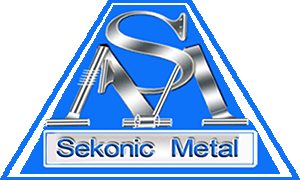MONEL Alloy K-500 (UNS N05500/ W.R.2.4375) is a nickel-copper alloy that combines the advantages of excellent corrosion resistance with greater strength and hardness of MONEL alloy 400. Aluminum and titanium were added to the nickel-copper base and heated under controlled conditions to precipitate submicroscopic Ni3(Ti, AI) particles throughout the nickel-copper base, thus improving the performance matrix. The use of hot work to achieve the effect of precipitation is often called aging hardening or aging.
Typical applications of MONEL alloy K-500 products are chain and cable fasteners and springs.
Marine Services: Pump and valve assemblies,
Chemical treatment: pulp processing in the production of paper for doctor’s blades and scrapers;
Oil well drilling and instruments, pump shaft and impeller, non-magnetic housing, safety lift and oil valve and natural gas production; And sensors and other electronic equipment components.

One of the properties of Monel K500 alloy is that it is virtually non-magnetic, even at quite low temperatures. However, it is possible to form a magnetic layer on the surface of the material during processing. Aluminum and copper can be selectively oxidized during heating, leaving a magnetic nickel-rich film on the outside of the sheet. This effect is particularly pronounced on thin wire or strip with a high surface-to-weight ratio. The magnetic film is removed by pickling or bright acid leaching to restore the non-magnetic properties of the material. The combination of low permeability, high strength, and excellent corrosion resistance has been used in many applications, especially well measurement equipment and electronic components.

It is found that Monel alloy K-500 has very good dimensional stability in long time exposure test and circulation test. This property of the alloy allows it to be used in high precision equipment such as gyros. The nominal range of tensile properties and hardness at room temperature is shown in Table 6. Approximate relationships between tensile properties and hardness for bars and forgings appear in Figs. 4 and 5, and similar relationships for sheets and strips appear in Figure 6. Table 7 compares the notch performance of smooth specimens. The short time and high temperature tensile properties of K500 alloy bars under various conditions are shown in the figure below. Hot rolled rods were tested at a speed of 0.016 inches/min through yield strength and 0.026 inches/min from there to break. Cold-drawn specimens were tested at a yield strength of 0.00075 inches/min, followed by 0.075 inches/min.


K-500 Monel alloy has excellent low temperature performance. Tensile strength and yield strength increase with decreasing temperature, while plasticity and toughness are almost unaffected. Even at temperatures as low as liquid hydrogen, the transition from tough to brittle does not occur. Therefore, the alloy is suitable for many low temperature applications. The performance of K-500 alloy base metal and welded sheet metal at -423°F is shown. If the aging treatment is carried out after the welding annealing material, the weld with the strength of the aging hardened base metal without serious loss of ductility can be obtained. Welding of age-hardened materials should be avoided because their ductility is greatly reduced.
MONEL alloy K-500 is designated as UNS N05500 and Werkstoff NR.2.4375. It is listed in NACEMR-01-75 Oil and Gas Services. Alloy K-500 is available in a wide range of standard mill forms including tube, tube, plate, strip, plate, round bar, flat bar, forgings, hexagon and wire. Plate, Sheet and Strip -BS3072NA18(Plate and strip),BS3073NA18(Strip),QQ-N-286(Plate, sheet and Strip),DIN 17750(Plate, Sheet and strip),ISO 6208(Sheet, Sheet and Strip) Bars, Bars, Wires and Forgings -BS3075NA18(Wire), BS3076NA18(Rod and rod),ASTM B 865(Rod and rod),DIN 17752(Rod and rod),DIN 17753(Wire),DIN 17754(Forgings),QQ-N-286(Rod, Rod, Wire and Forgings), SAE AMS 4676(Rods and rods),ASME Code Case 1192(Rods and rods),ISO 9723(rods),ISO 9724(Wire),ISO9725(Forgings) Tubes and Tubes -BS3074NA18(Seamless tubes and tubes),DIN 17751(Tubes and tubes) Other Products -DIN 17743(Chemical Composition),SAE AMS 4676(Chemical composition),QQ-N-286(Chemical composition)
Post time: Sep-20-2022



